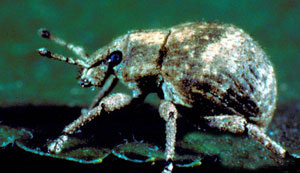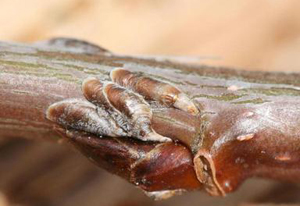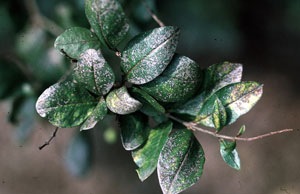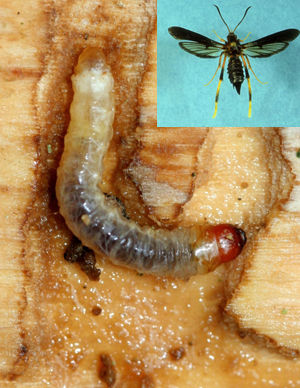Leaf Feeders

University of Georgia , University of Georgia, Bugwood.org
Two-banded Japanese weevil adults are about 1/4 inch long and pear shaped. Unlike other weevils, which have long snouts, this weevil has a stout, short snout. Adults have a mottled appearance, with grey and brown blotches giving them an almost camouflage-like appearance. There are two distinct bands that form across the back of the elytra. Larvae look like other weevils -- small, white, and legless. The adults feed along the edges of leaves, making notches at first, then tattered edges. In heavy infestations, whole leaves may be consumed. They overwinter as eggs, larvae, and adults. Overwintering adults resume feeding in May and produce the next generation with new adults emerging in June-July.
Sap Feeders

Whitney Cranshaw, Colorado State University, Bugwood.org
Oystershell scales are about 1/10 inch long and resemble crusty accumulations of oyster shells on the bark. Their drab, bark-like appearance makes them easy to overlook, even on close inspection. Heavy infestations can kill twigs or branches. This scale overwinters in the egg stage under the waxy covering of the female. The eggs hatch and the crawlers are active from late May to early June.

Whitney Cranshaw, Colorado State University, Bugwood.org
Privet thrips are very small elongate insects that rasp at leaf cells and feed on the released sap. Infested leaves have a dust gray cast, the lower surface is speckled with dark deposits of excrement. Immature stages are yellow, adults are dark brown to black with a red band.
Borers

larva: David Cappaert, Bugwood.org;
adult (inset): James Solomon, USDA Forest Service, Bugwood.org
Lilac borers are the caterpillar stage of a wasp-like moth that lays its eggs by wounds or roughened areas on the bark in August and September. The larvae tunnel under the bark and spend the winter there. They resume development in the spring. The larvae tunnel into the bark but maintain an opening where they expel their sawdust-like waste. The wound can be an entryway for a wood-destroying fungus. There is one generation per year.